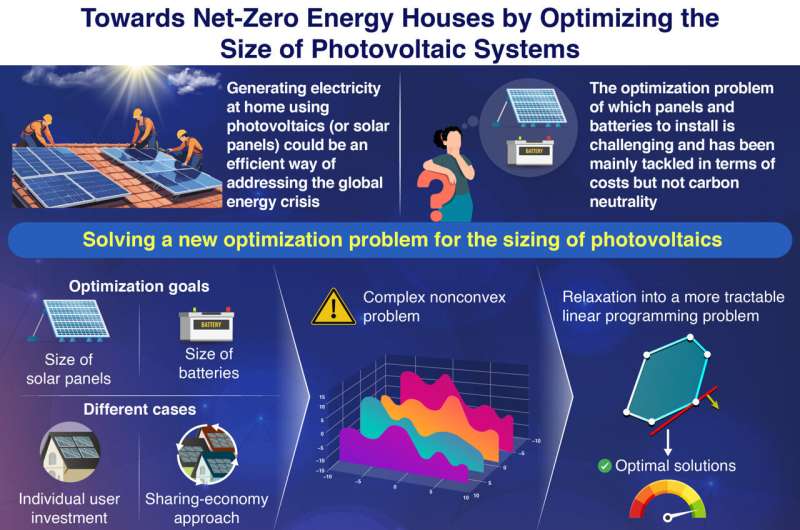This article has been reviewed according to Science X's editorial process and policies. Editors have highlighted the following attributes while ensuring the content's credibility:
fact-checked
peer-reviewed publication
trusted source
proofread
Towards net-zero energy houses: Optimizing the size of photovoltaic systems

Residential buildings account for a large percentage of global energy consumption, and many countries around the world are looking into effective solutions to this issue amidst the ongoing energy crisis. Consistent with global efforts to shift away from fossil fuels, an attractive option is to make houses self-sufficient by having them generate their electricity—something that is usually achieved using photovoltaic (PV) systems.
One recurrent problem when trying to promote PV systems in residential areas is calculating what size of solar panels and batteries are optimal for each house. Though it may seem deceptively simple, finding the optimal solution to this problem for many houses quickly becomes computationally intensive. This gets even worse if one accounts for a lot of uncertain factors, including variations in average solar radiation, energy consumption patterns, and the possibility of energy sharing between homes.
Against this backdrop, a research team from Japan, including Professor Takeshi Hatanaka from the Tokyo Institute of Technology, has come up with a new and efficient way of solving the above-mentioned optimization problem. As explained in their paper, which was recently published in IEEE Access on 6 June 2024, the proposed approach aims to realize net-zero energy houses (ZEHs)—that is, houses designed to have an annual net energy consumption close to zero. This work was collaborative research with Waseda University and University of Toyama.
First, the researchers formulated the optimization problem as a system of mathematical equations and inequalities that, when solved, provide the optimal sizing of PV panels and batteries in terms of both cost and carbon neutrality. They considered cases in which each home has to produce its energy alone, as well as cases in which energy sharing between homes is allowed, which is referred to as a "sharing economy."
The main challenge the team had to address was the fact that such complex optimization problems are usually non-convex. In other words, due to the nature of the problem, solver algorithms can get tricked into settling for a suboptimal solution. To address this issue, the researchers applied a series of clever transformations to turn the original problem into a linear programming (LP) problem, which is more easily tractable.
Afterward, to test their approach, the team applied the proposed framework to a neighborhood in Japan, for which both the energy consumption and solar generation data were available for 134 households. As expected, they could quickly find the optimal solutions for both individual and sharing economies.
"Our numerical examples leveraged real-world data instead of relying on synthetic data, enhancing the authenticity of our findings," highlights Hatanaka. "We demonstrated that attaining ZEH status does not significantly elevate costs, which implies that it is a feasible goal for residential houses in Japan."
Worth noting, the above experiment also revealed that commercially available solvers were unable to solve the original optimization problem due to its sheer complexity.
"When considering about two months of data, the original problem becomes computationally challenging, taking up to 14 hours to be solved by commercial solvers. In contrast, the full problem can be solved in less than ten seconds using our LP transformations," Hatanaka adds.
Taken together, the findings of this study could contribute significantly to the adoption and rollout of renewable energy systems in residential neighborhoods by enabling planners to get the sizing of solar panels and batteries just right. The researchers hope the efforts pave the way to cities full of ZEHs.
More information: A. Daniel Carnerero et al, Net-Zero Energy House-Oriented Linear Programming for the Sizing Problem of Photovoltaic Panels and Batteries, IEEE Access (2024). DOI: 10.1109/ACCESS.2024.3410369















